In this week’s blog post we will start looking over the news and updates for Simcenter STAR-CCM+ version 2022.1 that we released last week. I will here start by focusing completely on the updates relating to multiphase flow. Both for the Eulerian and the Lagrangian frameworks. I hope this will be useful to those of you out there that are focusing on the multiphase models.
VOF
Our first model to look at is the Volume of fluid model where some exciting news are allowing users to hopefully speed up their simulations.
MHRIC
The HRIC (High resolution interface capturing) scheme is used to track and maintain an interface between different fluid phases. It now comes in a modified version (the MHRIC). Since VOF is often used with AMR and adaptive timestep, an over resolution of the smallest droplets can occur. By producing a thicker interface (typically 3 cells thick) the method can smooth out a lot of issues like artifacts at the free surface associated with the mesh or perturbations and do so without the thicker interface leading to numerical mixture. A typical example where this method can lead to a speed up and maintain the relevant physics is tank sloshing.
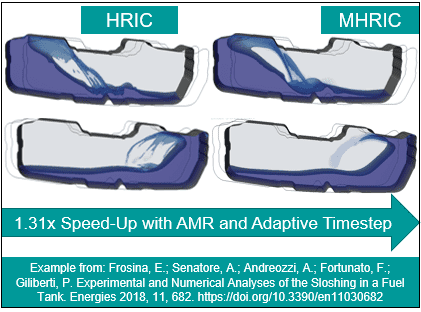
Implicit VOF multistep
Often a small timestep is required to resolve a VOF free surface. And the timestep is limited by the smallest length scales like for small droplets, even if the simulation also includes large waves. The rest of the flow field often allows for a larger time-step. The implicit VOF multi-step leverages this difference by sub-stepping for the volume fraction multiple times within the flow timestep giving an effective timestep for the volume fraction that is smaller than that for the flow that still meets the CFL constraints. While the explicit VOF-multistep guarantees a sharp interface everywhere, the new implicit multistep method gives the user some flexibility in what parts to resolve. The picture below shows a comparison between the methods in a simulation of a high-speed boat, comparing time and results.
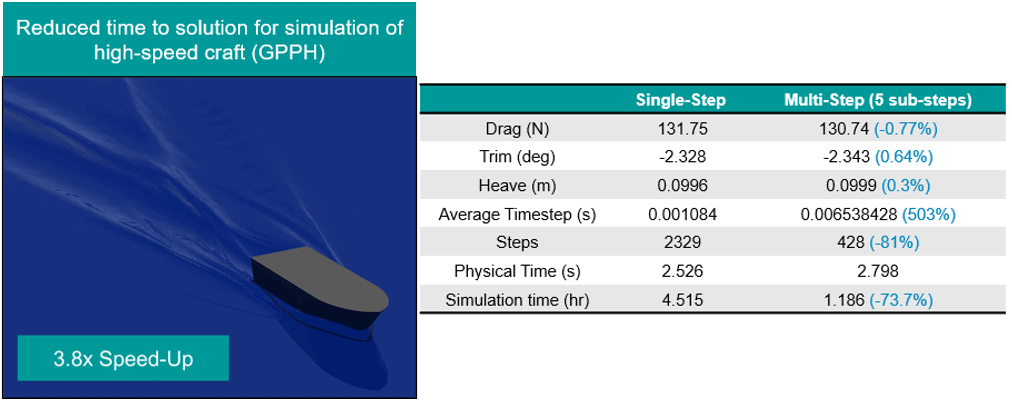
VOF to LMP transition
A new criterion is added for the transition between VOF and LMP particles, “limit to well-resolved blobs”. This makes sure that only blobs with a well resolved core is transitioned and reduced the risk of transitioning numerical mixtures into LMP-particles. The default value for transition is 0.95, it can be edited. This means that the blob-core at least must see a volume fraction of that value for transition to happen.
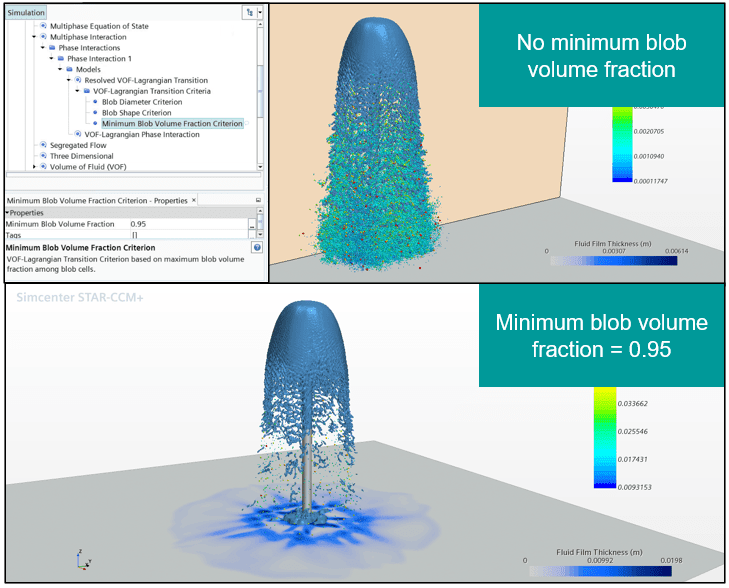
VOF-wave parametrizable properties
Another new addition for VOF is in the VOF Wave model. It is now possible to utilize parametrizable properties for the VOF wave forcing and dampening properties. These properties can now also be specified as field functions. This allows for sweeps or design exploration to be carried out.
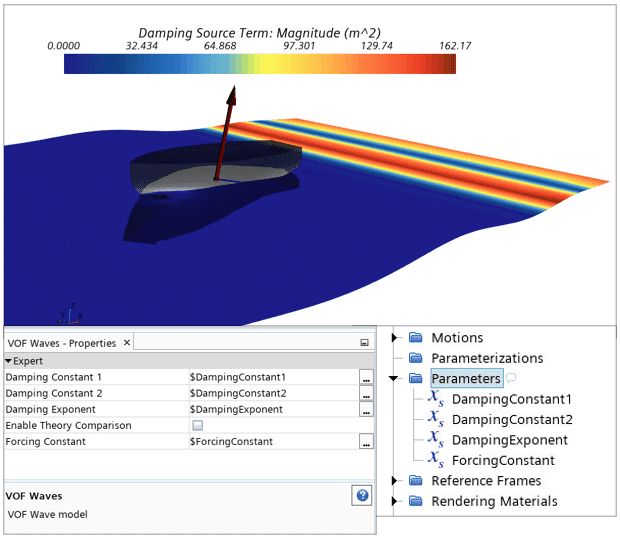
MMP
The mixture multiphase model is a good option where phase-properties can be seen as mixture. Or where mixture properties are a good assumption. The later inclusions of several sub models like LSI (Large Scale Interfaces) have increased the range of where MMP can be used.
Surface tension for MMP-LSI
Surface tension has been added to the MMP-LSI framework. Surface tension is important in many applications where small droplets, ligaments and rivulets need to be captured. Surface tension could already be modeled using VOF for these applications in previous releases together with dynamic contact angle and hysteresis effects, but these simulations require a high level of resolution everywhere and so can be computationally expensive. With the addition of surface tension to MMP-LSI such flow features can be captured in simulations that are part resolved and part modeled and mixtures also exist. With this approach, surface tension is applied in the cells in Large Scale Interface zone and other regions where there is insufficient resolution to resolve interfaces between phases are modeled as a mixture.
MMP/VOF Cell size and wall distance length scale limiters
When specifying interaction length scale between phases, it is common to use a constant value for interaction length scale, let’s say that that we use a bubble or droplet diameter of value X. This value is then assumed at all interfaces, even close to the wall. Large bubbles will not exist close to the wall. And when using the assumption that they do, this will lead to erroneous slip velocity calculations, which are often drag based. So, now, instead of using complex field functions to limit sizes close to the wall there are now included limiters for slip velocity. The options for limiter are Cell size and Wall distance.
EMP
The mother of all Eulerian models, the EMP, has also been given some attention in this version of the software.
AMR for EMP
Up till now, AMR has not been compatible with MMP, but now it is possible to run your EMP-cases with AMR. As usual, this helps increase the physical resolution of your simulation, but also remove some of your meshing needs, because you do not need to know beforehand where to utilize a finer mesh. The two new AMR-providers are User-defined mesh adaptation and LSI Mesh-refinement (for resolving large scale interfaces like free surfaces).
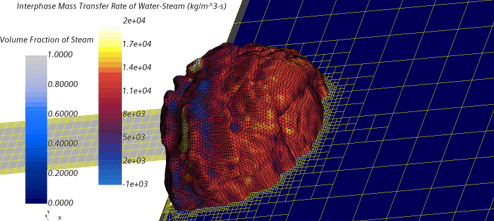
New models for droplet break up (S-gamma and AMUSIG)
There are two new models for breakup and coalescence for droplets in gas. The old models that are available focus mainly on hydrodynamics. The first model is The O’Rourke Coalescence Efficiency, where an equivalent model already exists for the Lagrangian framework. The other model is Kocamustafaogullari breakup rate, and this model account the gas velocity and its effects on break-up.
Real gas models for EMP and MMP
Real gas models have been available for many years for single phase and VOF, and for EMP and MMP only the IAPWS-IF97 (steam) has been available. But the complete list of Real gas models for both EMP and MMP is now:
- IAPWS-IF97 (steam)
- Modified Soave-Redlich-Kwong
- Peng-Robinson
- Redlich-Kwong
- Soave-Redlich-Kwong
- Van der Walls
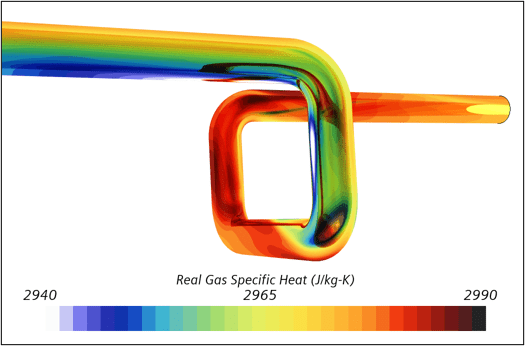
DMP
The last of our Eulerian models in the list is the DMP model, even if it somewhat of a lightweight model it has been given some attention over the last releases with population balance modelling and such.
DMP with AMR
The DMP model is now available with AMR. There is no specific refinement based on the DMP phases themselves, because of the low fractions used for a valid DMP-setup. So, instead you would typically refine when running a combination of DMP and VOF, where the refinement of the mesh is located on the free surface instead. You can however create a user defined refinement for the DMP-phases if required. The big plus is that DMP can be used in the same simulation as AMR.
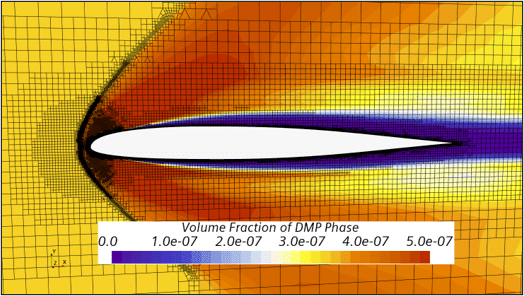
LMP and DEM
In the Lagrangian framework we follow particles (or parcels) as they travel and interact with a continuous flow. The additions for LMP in this release have to with increased capabilities in terms of components. For DEM some work has been done to expand the mesh free DEM capabilities.
Liquid-solid-gas mixture model
Where before a solid component would typically be represented by an inert liquid component, there is now a new model to account for a solid component in the Lagrangian particles. What this brings to the table, is now the removal of the homogenous particle assumption for this Liquid-solid-gas model in reference to evaporation. Evaporation is now dynamically reduced for a particle, due to the formation of a porous crust, as remaining solid component while moisture removal is happening.
A good application here is the in the food industry, where milk is during (as in the movies below), or in drying of wet solids.
Multi component bubbles in VOF-LMP transition model
Both in relation to LMP and VOF, it is now support for multi-component bubbles in the VOF to Lagrangian transition model. This now provides a faster turnaround time to the hybrid multiphase approach. Typically, the formation of multi-component bubbles is resolved with VOF and the tracking of bubbles (particles) are done with LMP. It combines AMR with cell clustering to balance accuracy and turnaround time.
Flexible fibers with meshfree DEM
The flexible fibers are a DEM particle model that was introduced in the last version (2021.3). Basically, instead of using spherical particles segments, it is possible to combine and use cylinders instead, allowing for several order of magnitude faster calculations. The news for this version is that they can now be run in the mesh-free framework.
I hope this post has been informative in terms of understanding the multiphase capabilities introduced in the latest version of Simcenter STAR-CCM+. Do not hesitate to reach out to support@volupe.com if there are any questions, and I will be happy to help.
Author

Robin Victor
+46731473121
support@volupe.com